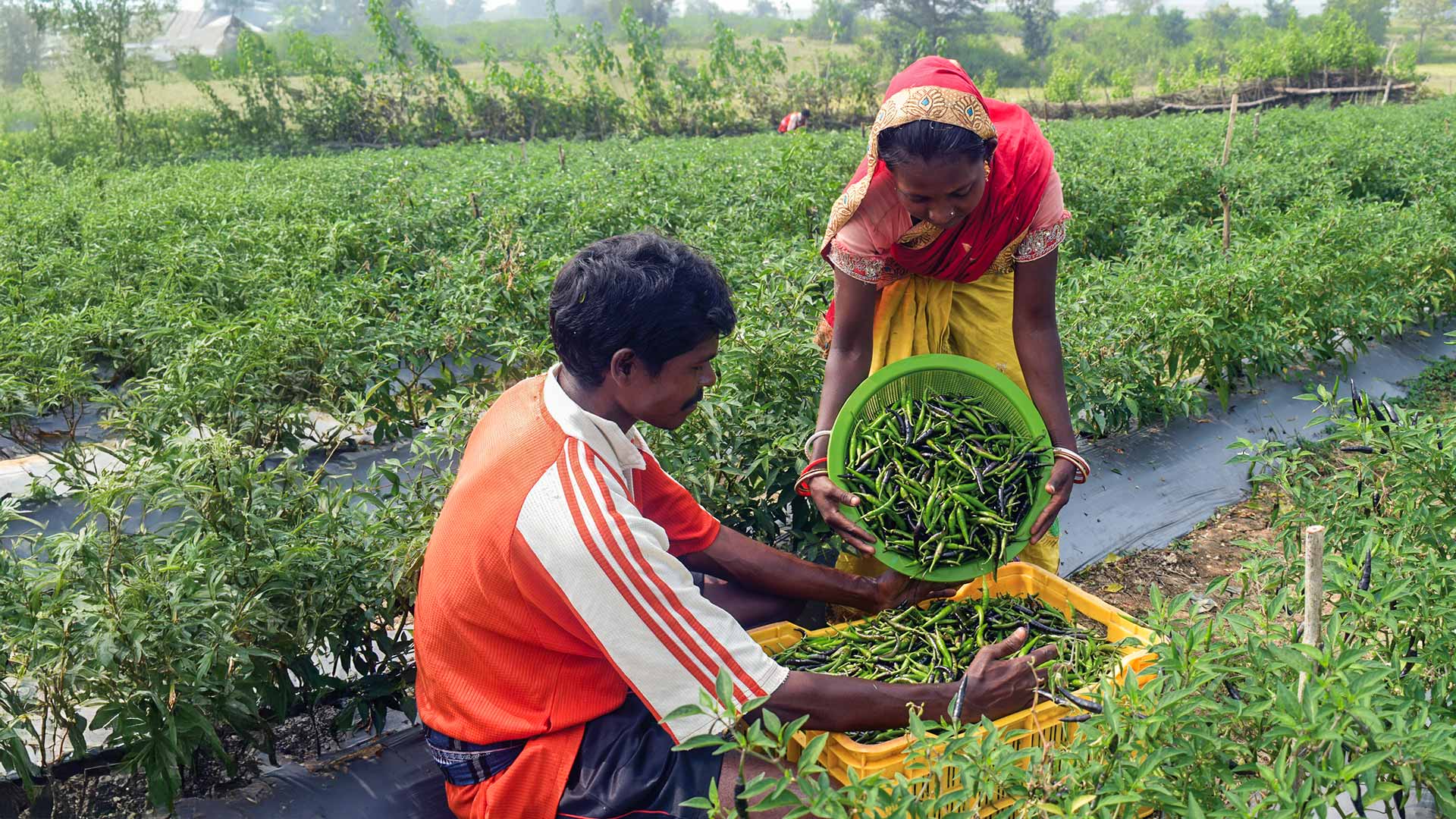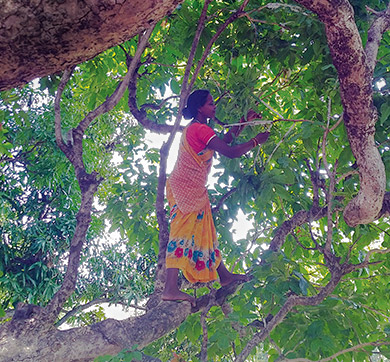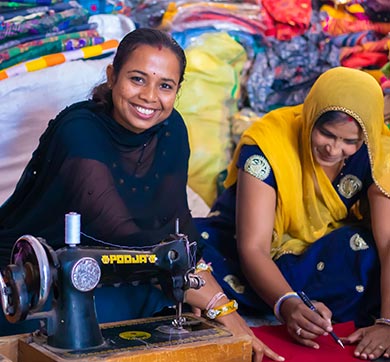September 2024 | 1871 words | 7-minute read
In Moti Kharaj village in Gujarat, Sarojben Gopalbhai Bariya struggled to support her six-member family while employing traditional mono-cropping methods on their two acres of rain-fed land.
Unreliable monsoons and mounting cultivation costs took their toll. The family’s fortunes changed when Sarojben joined the Vikas Sakhi Mandal self-help group (SHG) as part of Tata Trusts’ Lakhpati Kisan: Smart Villages programme. Exposure visits, training programmes, agri technologies, and access to government schemes, helped her to quickly transition to diversified agriculture and allied livelihoods. She adopted high-value vegetable cultivation and ventured into the cultivation of winter and summer crops. Her annual income shot up to over Rs 2 lakh.
Sarojben’s journey epitomises the transformative effect the programme has had on tribal and rural small and marginal farmers in India. Launched in 2015 by Tata Trusts and its associate organisation Collectives for Integrated Livelihood Initiatives (CInI), the programme aims to alleviate tribal and rural poverty while enhancing agricultural and allied livelihood productivity through a layered approach. The larger goal is the economic and social empowerment of tribal communities in an irreversible manner.
“Our programme’s metrics for success transcend the economic advancements of small and marginal households,” says Ganesh Neelam, Executive Director, CInI. “What is equally, if not more, important is the empowerment of local communities, especially women, who are pivotal to the programme. This is a crucial factor to assure irreversible change and positive, long-lasting effects cascading across these regional societies.”

Seeding a lakh
The programme was launched with more than one lakh tribal families across high poverty blocks in 13 districts in Jharkhand, Odisha, Gujarat, and Maharashtra. The goal was to use multi-layered livelihood interventions (agriculture, livestock, non-timber forest produce) to set these families on the path to being lakhpatis — earning more than Rs 1 lakh in a year — in about six years.
The programme’s focus had arisen out of CInI’s work in central India since 2007. In the years following its inception in 2007, CInI had designed programmes on crop stabilisation for regions where food security was an issue. In 2014, Ratan N Tata, Chairman Emeritus, Tata Sons, and Chairman, Tata Trusts, asked CInI to understand the aspirations of these tribal and rural communities and devise a programme that would make a lasting and irreversible impact. The feedback became the seed that grew into the Lakhpati Kisan programme.
Developing the model
The CInI team spent six months engaging with the community, specifically with women, SHGs and local institutions. They were invited to draw the future they envisioned for their families, specifically with regard to economic security. The women were excited about the opportunity to reimagine their lives. “The women told us that they would like a monthly income of Rs 10,000 to Rs 15,000 to take care of their household needs, children’s education, medical expenses, etc,” says Mr Neelam. “That figure became our goal.” The families aspired to earn Rs 1.2 - Rs 1.8 lakh per annum, a figure that inspired the women to suggest the programme name. The women also articulated the idea for the Scooty Didi mascot. It showed the Didi riding a scooty and dropping her child to school while also taking fresh vegetables to be sold in the market.
To make the programme viable, it was decided that the income would be generated through the family’s existing resources, such as land, livestock and, in some geographies, non-timber forest produce or their capabilities. This meant building on existing livelihoods, whether they were agriculture, livestock- or forest-based.

While paddy is the main crop in Jharkhand and Orissa, and maize is the main crop in Gujarat and Maharashtra, the team encourages and trains farmers to grow vegetables such as tomatoes, bell pepper, and cauliflower, depending on the agro climate, that have a high demand and market linkages. Farmers are also introduced to a layered approach, where they engage in high-value agriculture and take up other activities, such as raising livestock (small ruminants) or cultivating non-timber forest produce like lac, which also has a high demand. This helps families diversify their incomes and better weather market price fluctuations and other risks. The programme focused on the livelihood layers that, along with value chain implementation, would ensure an annual income of Rs 30,000 - Rs 40,000.
While the goal was permanent, in agreement with the community, the on-ground execution was intentionally kept flexible and dynamic. “If you engage intensively with the community, you will definitely see positive changes over the years,” says Mr Neelam. “The community may at first be unwilling to take risks, but once they see the outcomes within their larger ecosystem, they readily engage with the programme and take ownership.”
Empowering the community
The support of SHGs, village organisations, producer groups, federations, and farmer producer companies has proved critical in helping target households to get quality services and products to grow and achieve their aspirations.
“We undertake measures like capacity building, member empowerment and leadership development,” says Mr Neelam. “We work with self-help groups and apex institutions like farmer producer organisations and federations. Reinforcing community institutions is vital to upholding the key drivers of change being implemented.”
Once strengthened, these community institutions take the lead in taking the programme ahead sustainably. They spearhead the development process and support target households with interventions geared towards climate resilience, advise on service-led innovations and practices focused on water management, soil conservation, livestock and animal husbandry, and provide guidance on market realities.
Firm foundation
The Lakhpati Kisan programme is built on five principles.
- Community-centred approach: While the programme is facilitated by CInI, it has to be driven by the community, specifically women and their institutions.
- Stakeholder buy-in: The initiative design requires households to contribute 10-30% of the required resources, in terms of land, livestock, etc, depending on the type of intervention required, to ensure a sense of ownership and sustainability. The balance is provided through grants, government schemes, and financing.
- Demand- and market-led interventions: Farmers are encouraged to cultivate high-value crops based on market demand.
- Innovative, not stereotyped: The programme guides households and local entrepreneurs on how to increase productivity and improve farming practices using new and relevant technologies.
- Environmental sustainability: Interventions are planned keeping the larger climate change challenges and other environmental factors in mind, with a special focus on soil and water, with integration of relevant technologies.
A key part of the initiative are change agents called Lead Didis/Tais/Behns and Samajhdaar Lakhpati Didis. They are members of women SHGs who have a deep understanding of the interventions and are themselves early adopters with leadership skills. Through its leadership development initiatives, CInI empowers these women to be influencers, encouraging more households to adopt the new strategies and technologies to secure their livelihoods.
“We have a programme called Urja, through which we seek to trigger a fire within women, to both anchor the programme and deliver it on the ground,” says Mr Neelam. “We keep doing these events with women leaders to ensure long-term sustainability.”
Were it not for the support from community-led institutions, the target households would still be dependent on CInI. “That’s why we define sustainability as the capacity and capability of the institutions to be strong enough to anchor the engagement and provide these services to the community,” says Mr Neelam.
Growing lakhpatis
Since its beginning in 2015, the Lakhpati Kisan programme has made great strides. In Phase 1 (2015-2021), 45,000 tribal families were transformed into lakhpatis. Interventions also helped 20,000-25,000 families earn Rs 80,000-Rs 90,000 annually, while another 20,000-25,000 families earned almost Rs 50,000. These incomes are against the baseline annual income of Rs 35,000. The lower incomes are due to resources availability, labour, risk taking ability, etc at the family level.
On the development front, 80+ market-linked production hubs have been created for value chain growth, with the integration of polyhouse entrepreneurship, drip irrigation, solar irrigation, crop advisory, and market linkages. Around 250+ rural and tribal entrepreneurs are cultivating commercial soil-less nurseries, brood lac, livestock, water, among others.
Water management and irrigation are key enablers and the programme has created 2,540+ irrigation structures, thereby bringing 15,000acres under irrigation and ensuring year-round agricultural water for 40,000+ households.

Given the focus on technology and the environment, the programme has introduced changes such as the use of drips, solar pumps, insect traps, cold storages, crop advisory and land digitisation. The CInI team has also developed a Lakhpati Kisan data collection system to aid the programme.
In Phase 2, the programme is being extended to include another 1,00,000 families, while continuing to strengthen the Phase 1 families. CInI will accelerate its efforts and focus on further capacity building to encourage apex community-based institutions to take greater ownership. The scale and saturation is being driven by women-led institutions. CInI is facilitating the linkages with various stakeholders, such as technology partners, financing institutions, government, donors, markets, etc, for overall growth.
“In this phase, we are seeing local entrepreneurs and homegrown institutions take on more responsibility,” says Mr Neelam. “This is leadership in action. On our part, we continue to support the programme by getting other donors, who contribute financially towards the programme’s implementation, and the government, specifically through schemes, to come on-board.”
Sustainable growth
The Trusts believes that the key to building smart villages is the creation of resilient communities that aspire to achieve sustainable development without depleting natural resources. It encourages communities to transition to clean technology and renewable energy sources, reduce greenhouse gas emissions through smart interventions, and implement advanced agricultural practices.
“We want to operate in ways that are both socially responsible and environmentally sustainable,” says Mr Neelam. “We have aligned our initiatives with the United Nations’ Sustainable Development Goals. Our commitment to help India achieve these global goals underpins our efforts to promote inclusive, sustainable and lasting development, driving our core purpose of ‘leaving no one behind’.”
Beyond livelihoods
No social problem exists in isolation. Issues such as livelihoods, health, water, education, nutrition and sanitation are often interlinked. Their resolution is important for community development. The programme is focused on enabling families to use their increased income to improve their overall quality of life, especially with regard to water, sanitation, etc. Therefore, “the Lakhpati Kisan programme has evolved to integrate other crucial areas such as drinking water, sanitation and menstrual hygiene management into its objectives,” says Mr Neelam.
So far, the programme has initiated multi-sector interventions along with livelihood activities for 35,000 households. “Once the family income rises, consumption patterns change,” says Mr Neelam. “They begin to make investments towards children’s education, better nutrition and healthcare. Drinking water, the construction of toilets, and purchasing assets are other important priorities, which the women decide on.” These are all markers of a better quality of life and serve to ensure that the rise out of poverty is irreversible. He adds, “By strategically driving economic, social, and environmental change, the Lakhpati Kisan programme aims to bring individuals and households out of poverty sustainably, recognising how empowerment and support across multiple dimensions are essential to make these gains irrevocable.”
—Cynthia Rodrigues































